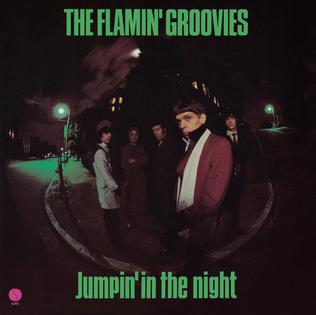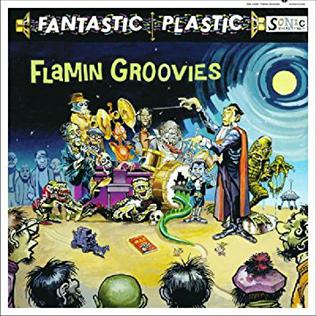
Cracker is an American rock band, formed in 1990 by lead singer David Lowery and guitarist Johnny Hickman. The band's first album Cracker was released in 1992 on Virgin Records; it included the single "Teen Angst ", which went to #1 on the U.S. Modern Rock chart. The band's follow-up, the 1993 album Kerosene Hat included the hit songs "Low", "Get Off This", and "Euro-Trash Girl".
Power pop is a subgenre of rock music and a form of pop rock based on the early music of bands such as the Who, the Beatles, the Beach Boys, and the Byrds. It typically incorporates melodic hooks, vocal harmonies, an energetic performance, and cheerful sounding music underpinned by a sense of yearning, longing, despair, or self-empowerment. The sound is primarily rooted in pop and rock traditions of the early-to-mid 1960s, although some artists have occasionally drawn from later styles such as punk, new wave, glam rock, pub rock, college rock, and neo-psychedelia.
Flamin' Groovies is an American rock band that formed in San Francisco in 1965, originally co-led by Roy Loney and Cyril Jordan. After the Groovies released three albums, on Epic (Supersnazz) and Kama Sutra, Loney left the band in 1971. He was replaced as co-leader by Chris Wilson, and the band's emphasis shifted more toward British Invasion power pop.

Pink Flag is the debut studio album by English rock band Wire. It was released in November 1977 by Harvest Records. The album gained Wire a cult following within independent and post-punk music upon its initial release, later growing to be highly influential on many other musicians.

Vintage Violence is the debut solo studio album by Welsh musician John Cale, released on 25 March 1970 by Columbia Records. Cale and Lewis Merenstein produced the album.

Teenage Head is the third studio album by the San Francisco rock band Flamin' Groovies, released in March 1971 by Kama Sutra Records.

Groovies' Greatest Grooves is a 1989 compilation album by U.S. rock band the Flamin' Groovies, released by Sire Records. The tracks were selected by Rolling Stone Senior Writer Michael Goldberg and freelance rock critic Michael Snyder, who also co-wrote the liner notes. Goldberg and Snyder wanted to emphasize the Groovies' original material, and so 18 of the album's 24 songs are Groovies originals.

Chris Wilson is a guitarist and multi-instrumentalist, most known for his role as the lead singer of the San Francisco band the Flamin' Groovies, having replaced original singer Roy Loney in 1971. With Wilson on lead vocals, the band released their influential 1976 album Shake Some Action.
Cyril Jordan is a guitarist and founding member of San Francisco cult band the Flamin' Groovies. Jordan founded the band in 1965, playing with them until they initially disbanded in 1992.

Flamingo is the second studio album by the rock band the Flamin' Groovies. It was released in 1970. Following the group's departure from the Epic record label, it was the first of their two albums for Kama Sutra Records.

Supersnazz is the debut studio album by the rock band the Flamin' Groovies. It was released in 1969 on the Epic label. The release was their only album recorded expressly for a major record label, although all of their next five albums were distributed by major labels. Supersnazz was later released in compact disc format in 2000 on Sundazed Records with four edits of songs from the album included as bonus tracks.

Flamin' Groovies Now is a studio album by the Flamin' Groovies, released in 1978. It was produced by Dave Edmunds, and marked a resurgence of the San Francisco band. The band supported the album with a lengthy UK tour.

Jumpin' in the Night is the sixth studio album by the Flamin' Groovies, released in 1979. It was produced by Cyril Jordan and Roger Bechirian.

Fantastic Plastic is the ninth studio album by The Flamin' Groovies, released on September 22, 2017, and produced by Cyril Jordan and J. Jaffe. The first new album from the Groovies since 1993, it features the reunion of the Groovies most commercially successful line-up, the classic 1970s combo of guitarists/vocalists Jordan and Chris Wilson and bassist George Alexander, who recorded three albums together before splitting up in 1981.

One Night Stand is an album by the Flamin' Groovies. It was released in 1987 and produced by Cyril Jordan, who also provided the cover art. The album was recorded "live in the studio" in a single night in Australia by the then-current version of the Groovies during a "grueling" tour of Australia, Japan and Europe.

Rock Juice is the eighth studio album by the Flamin' Groovies, released in September 1993 and produced by Cyril Jordan, who also provided the cover art, and Karl Derfler. The album was completed by Jordan and Groovies' bassist George Alexander after the group's breakup in 1991, and they are the only musicians credited in the liner notes.

A Bucket of Brains is a studio EP/CD by the Flamin' Groovies, primarily consisting of seven songs recorded by the group while living in England and recording for the British branch of United Artists Records ("UA") in 1972. The songs were intended to form the basis of the Groovies' fourth studio album, to be entitled A Bucket of Brains. Six of the songs were produced by Dave Edmunds, while the seventh was produced by Groovies' leader Cyril Jordan. The eighth song on the album is the original "correct speed" studio version of the Groovies' most famous song, "Shake Some Action".

Step Up is a compilation album of in-studio demos recorded by the Flamin' Groovies in the San Francisco Bay Area between 1984 and 1989 and released in 1991. The demos were produced by Cyril Jordan and engineered and mixed by Karl Derfler, and the album was released shortly after the band broke up. However, after the breakup, eight of the 13 songs were reworked and remixed by Jordan and Derfler, along with removing all lead and backing vocals except for those by Jordan and Groovies' bassist George Alexander, and were then ultimately issued on the Groovies' eighth studio album Rock Juice in 1993.

Roy Loney was an American rock musician, best known as the original lead singer of the Flamin' Groovies. The Groovies original line-up issued releases on Epic Records and Kama Sutra Records, which Rolling Stone magazine described as an "influence on power-pop and punk ..." Loney's albums with the Flamin' Groovies included Sneakers (EP), Supersnazz, Flamingo, and Teenage Head. Billboard magazine contrasted their "gritty" sound to the "flower power" approach of their San Francisco contemporaries.
Charlie Pickett is an American singer and guitarist, known as frontman for rock bands from Florida, most notably in the 1980s. In Rolling Stone, David Fricke described Pickett's music as "a brawling-roots mix of Johnny Thunders, Sun Records and trailer park Lou Reed in Florida bars."
















